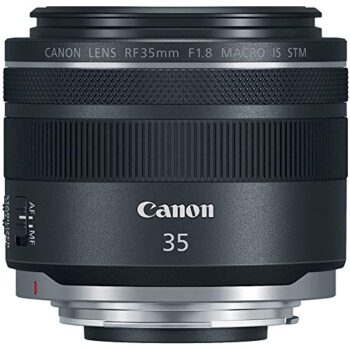Canon RF 35mm F1.8 IS Macro STM Technical Review: The Swiss Army Knife of the RF Mount
Introduction: Redefining the “Normal” Prime Lens
In the ecosystem of any camera system, the “normal” prime lens—typically a 35mm or 50mm—holds a place of special reverence. It is often the first prime lens a photographer buys, the gateway to the creative possibilities of wide apertures and the disciplined art of “zooming with your feet.” It must be a jack-of-all-trades: small enough to be unobtrusive, sharp enough to resolve fine detail, and fast enough to conquer challenging light. When Canon launched its revolutionary mirrorless RF mount, the pressure was on to create a standard prime that not only met these expectations but redefined them for a new generation of hybrid creators. The result of that challenge is the Canon RF 35mm F1.8 IS Macro STM, a lens that is not just a jack-of-all-trades, but a master of many.
This is far more than a simple “nifty fifty” equivalent for the RF system. It is a lens of profound and surprising versatility, a compact powerhouse that ingeniously packs four distinct personalities into a single, affordable body. It is, first and foremost, a brilliant standard prime. Its 35mm focal length offers a natural, slightly wide field of view that is perfect for street photography, environmental portraits, and documentary storytelling. Secondly, its ultra-bright f/1.8 aperture transforms it into a low-light champion, capable of gathering immense amounts of light for indoor and nighttime shooting while creating beautiful, subject-isolating bokeh. Thirdly, in a move that elevates its utility immensely, Canon has integrated a powerful 5-stop Optical Image Stabilizer, a feature almost unheard of in a prime lens of this class, making it an incredible tool for handheld video and low-light stills. And finally, in its most surprising and valuable trick, it is a true macro lens, capable of 1:2 life-size magnification that opens up a whole new world of close-up photography.
This lens is a statement of intent for the RF system, demonstrating a commitment to creating innovative, high-performance tools that are accessible to a wide range of creators, from serious enthusiasts to working professionals. In this exhaustive technical review, we will perform a granular dissection of the optical and mechanical engineering that makes the RF 35mm F1.8 a modern classic. We will analyze the physics of its optical formula, deconstruct the mechanics of its stabilization system, and evaluate the real-world performance that makes it arguably the most versatile and valuable prime lens in the entire Canon RF lineup. This is a deep dive for the discerning photographer and videographer who wants to understand why this compact lens is, quite simply, a masterpiece of modern optical design.

A Deep Dive into the Key Features: A Granular Analysis of a Multi-Talented Optic
The extraordinary versatility of the Canon RF 35mm F1.8 is not the result of a single specification but the clever and synergistic integration of multiple high-performance technologies. We will now dissect each key feature from a technical perspective to understand its scientific basis and its tangible impact on the creative process.
-
The Hidden Superpower: 0.5x Magnification Macro and Close Focusing
The most surprising and arguably most valuable feature of this lens is its designation as a “Macro” lens. Specifically, it offers a 0.5x magnification ratio, which is also expressed as 1:2 life-size. From a technical standpoint, this means that when the lens is at its closest focusing distance, the image projected onto the camera’s sensor is half the physical size of the subject in real life. This is achieved by the lens’s remarkable minimum focusing distance of just 0.17 meters (0.56 feet). This is the distance from the camera’s sensor plane to the subject, meaning the front of the lens can get incredibly close to what you are shooting.
While a “true” macro lens is defined by a 1.0x (1:1) magnification ratio, the 1:2 capability of the RF 35mm is immensely powerful and versatile. It unlocks a world of creative possibilities that are completely inaccessible with standard prime lenses, which typically have minimum focusing distances of a foot or more. This feature transforms the lens into an exceptional tool for a huge range of applications. For wedding and event photographers, it’s perfect for capturing detailed shots of rings, invitations, and floral arrangements. For food bloggers and commercial photographers, it allows for mouth-watering, frame-filling shots of textures and ingredients. For nature enthusiasts, it’s a fantastic lens for capturing the intricate details of flowers and larger insects. This built-in macro functionality effectively eliminates the need for a separate, dedicated macro lens for a vast number of users, representing an incredible consolidation of gear and an immense value proposition.
-
The Low-Light Champion: 5-Stop Optical Image Stabilization (IS)
The inclusion of a powerful Optical Image Stabilization (IS) system in a compact, wide-aperture prime lens is a monumental engineering feat. This system is designed to counteract the photographer’s natural hand movements, which cause camera shake and lead to blurry photos, especially at slow shutter speeds. It works using a pair of high-precision gyroscopic sensors within the lens that detect the angular velocity of any pitch and yaw movements. This data is instantly processed, and a dedicated group of lens elements—the IS group—is physically shifted in the opposite direction of the shake, effectively stabilizing the image before it hits the sensor. The system in the RF 35mm is rated for up to 5 Stops of shake correction. This is a CIPA-rated, scientific measurement. One “stop” represents a doubling of light. A 5-stop advantage means you can achieve a critically sharp handheld photograph at a shutter speed that is 32 times slower (2^5 = 32) than the standard “1/focal length” rule would suggest. In practice, this means capturing sharp, detailed images handheld in dimly lit interiors, at twilight, or at night, without having to crank up the ISO to noisy levels or resort to a tripod. This is a game-changing capability for street, event, and travel photography.
For hybrid shooters and videographers, the benefit is equally profound. The IS system dramatically reduces the jitter and micro-vibrations inherent in handheld video recording, producing footage that is significantly smoother and more professional-looking. When this lens is paired with a Canon EOS R series body that also features In-Body Image Stabilization (IBIS), such as the R5 or R6, the two systems work in a coordinated fashion, sharing data via the high-speed RF mount to provide an even higher level of stability, making smooth, gimbal-like movements possible.

-
The RF Mount Advantage: The 12-Pin Communication System and Control Ring
The foundation of this lens’s advanced capabilities is the Canon RF mount itself. It features a 12-pin electronic communication system, a significant upgrade from the 8 pins of the older EF mount. This provides a much faster, higher-bandwidth data connection between the lens and the camera body. This high-speed communication is the enabler for several key technologies. It allows for the real-time application of Canon’s **Digital Lens Optimizer (DLO)**, where the camera’s processor receives a detailed optical profile from the lens and makes instantaneous corrections for diffraction, aberrations, and peripheral illumination, resulting in a cleaner, sharper JPEG file straight out of the camera. This communication speed is also what facilitates the coordinated IS between the lens and IBIS-equipped bodies.
A tangible benefit of this system is the signature RF lens feature: the customizable Control Ring. This is a dedicated, third ring on the lens barrel (in addition to the focus ring) that can be programmed via the camera menu to provide direct, tactile control over a key exposure setting. A user can assign it to adjust aperture, ISO, shutter speed, or exposure compensation. The ring has a satisfying click-stop mechanism, allowing the photographer to make precise adjustments by feel, without ever needing to take their eye away from the viewfinder. This is a massive ergonomic and workflow enhancement for professionals who need to react instantly to changing conditions. For videographers, this click can be removed by a Canon service center for a small fee, allowing for smooth, silent aperture adjustments while recording.
-
The Heart of the Lens: The Bright F1.8 Aperture
The lens’s designation as an **F1.8** optic is central to its identity. This refers to its maximum aperture, which is incredibly large or “fast.” A large aperture allows the lens to gather a tremendous amount of light, making it a low-light powerhouse. Compared to a standard f/4 kit lens, an f/1.8 aperture gathers more than four times the amount of light. This provides a huge advantage when shooting indoors, at night, or in any dimly lit environment. It allows the photographer to use a faster shutter speed to freeze motion and a lower ISO to keep the image clean and free of digital noise. From a creative standpoint, the f/1.8 aperture is a tool for creating a very shallow depth of field. It allows you to render your subject in tack-sharp focus while melting the background away into a beautiful, creamy blur (bokeh). This subject isolation is the key to creating professional-looking portraits and artistic shots where the subject is the clear hero of the image.
-
Smooth and Silent Operator: The STM Autofocus Motor
The RF 35mm utilizes a lead-screw-type Stepping Motor (STM) for its autofocus drive. This motor technology is renowned for its exceptional smoothness and near-silent operation. An STM motor works by moving the focusing group of lens elements in a series of precise, discrete “steps,” which are controlled electronically. This allows for incredibly smooth and controlled focus transitions, which is a massive advantage for videography. When shooting video, the STM motor can produce cinematic, professional-looking focus racks from one subject to another without the distracting noise or abrupt, jerky movements that older motor types could produce. While a more advanced Nano USM motor (found in higher-end L-series lenses) offers greater top-end speed for tracking very fast-moving subjects in still photography, the STM in this lens is quick, accurate, and more than capable for the vast majority of photographic applications, including street, portrait, and documentary work. Its optimization for silent, smooth video performance makes it the ideal choice for this versatile, hybrid-oriented lens.
Pros: The Undeniable Technical Strengths
- Incredible Versatility: Brilliantly combines four lenses in one: a standard prime, a low-light specialist, a stabilized video lens, and a 1:2 macro lens.
- Superb Low-Light Performance: The combination of a bright f/1.8 maximum aperture and a powerful 5-stop Optical Image Stabilizer makes it a champion in challenging light.
- Excellent Image Quality: Delivers sharp, detailed images with pleasing color rendition and beautiful bokeh, especially when stopped down slightly.
- Unique and Powerful Macro Capability: The 0.5x magnification opens up a world of creative close-up photography, a feature almost never found in a standard prime.
- Optimized for Hybrid Shooting: The silent and smooth STM autofocus motor and effective IS system make it an outstanding choice for vloggers and filmmakers.
- Compact, Lightweight, and Affordable: For an RF mount lens with this feature set, its small size, low weight, and accessible price point make it an exceptional value.
- Advanced Ergonomics: The customizable RF Control Ring provides a direct, tactile control interface that significantly enhances the professional shooting experience.
Cons: Important Technical Considerations and Trade-offs
- Not L-Series Build or Weather Sealing: As a consumer-grade lens, it does not feature the robust build quality or extensive weather sealing of Canon’s professional “L” series lenses. It should be used with care in inclement weather.
- Noticeable Focus Breathing: The lens exhibits a significant amount of focus breathing (a change in the field of view when changing focus), which can be distracting for high-end cinematic focus pulls.
- Autofocus Motor Noise: While the STM motor is very quiet, the lens barrel does physically extend to focus, and this mechanical movement is not completely silent and can be picked up by the camera’s internal microphone in a very quiet room. An external mic is recommended for pro audio.
- Optical Imperfections When Wide Open: Like most fast prime lenses in its class, it exhibits some optical softness in the extreme corners and noticeable vignetting when shot wide open at f/1.8. These characteristics improve dramatically by stopping down to f/2.8 and are also effectively corrected by in-camera lens profiles.
- STM Speed Limitation: While smooth, the STM motor does not have the top-end speed of a Nano USM motor for tracking extremely fast and erratic subjects in high-speed burst shooting.
Conclusion: The Most Indispensable Lens in the RF System
The Canon RF 35mm F1.8 IS Macro STM is a triumph of modern lens design and a testament to the potential of the RF mount. It is, without exaggeration, the “Swiss Army knife” of the entire Canon mirrorless system. It masterfully blends excellent optical quality with an almost unbelievable suite of high-performance features—a fast f/1.8 aperture, 5-stop IS, and 1:2 macro—into a body that remains compact, lightweight, and remarkably affordable. It is a lens that defies categorization, serving with equal brilliance as a street photographer’s candid companion, a vlogger’s stabilized storytelling tool, a portraitist’s bokeh machine, and a product photographer’s detailed eye.
While it makes logical compromises in build quality and AF speed compared to its L-series brethren, its real-world performance and creative versatility are simply staggering for its price. It is the lens that empowers creators to shoot in dimly lit cafes, to capture the delicate details of a wedding ring, and to film smooth, stable handheld video, all without ever changing what’s on their camera. For the new EOS R series owner, this is unequivocally the first prime lens to buy. For the seasoned professional, it is the lightweight, multi-talented optic that will earn a permanent place in their bag. It is not just a great lens; it is an essential one, and it receives our highest possible recommendation as the best all-around value and performance leader in the Canon RF lineup.
Frequently Asked Questions (FAQs)
- Q1: What is the main technical difference between this lens and a more expensive “L” series lens?
- A: The main differences are in build quality and optical corrections. “L” series lenses, like the RF 24-70mm F2.8L, feature rugged, metal construction and extensive weather sealing for professional use in harsh conditions. They also typically employ more exotic and numerous special lens elements to achieve near-optical perfection, even wide open. This lens has a high-quality plastic construction, lacks weather sealing, and makes some optical compromises (like vignetting at f/1.8) that are corrected digitally.
- Q2: Is this a “true” macro lens? What does 0.5x or 1:2 magnification mean?
- A: In strict technical terms, a “true” macro lens achieves 1.0x or 1:1 magnification, meaning the image on the sensor is the same size as the object. This lens achieves 0.5x or 1:2 magnification, meaning the image on the sensor is half the size of the object. While not 1:1, this is incredibly powerful and much closer than a standard lens, making it excellent for all but the most specialized insect or scientific macro photography. It’s more than capable for flowers, food, products, and details.
- Q3: How does the STM motor compare to a Nano USM motor for video?
- A: Both are excellent for video. The STM (Stepping Motor) in this lens is known for its exceptional smoothness during focus transitions. A Nano USM is a hybrid motor that is both very smooth and extremely fast. For most cinematic focus pulls, the STM’s smoothness is arguably more desirable. The main advantage of Nano USM is its superior speed for tracking fast-moving subjects in still photography.
- Q4: If my camera has In-Body Image Stabilization (IBIS), does the lens’s IS still do anything?
- A: Yes, they work together to create an even more powerful stabilization system. The high-speed RF mount allows the lens IS and camera IBIS to communicate and coordinate their movements. The lens IS is typically better at correcting for longer, slower movements, while the IBIS is better at correcting for high-frequency vibrations. Together, they provide a level of stability (up to 7 stops on some bodies) that is superior to what either system could achieve on its own.
- Q5: Can I use this lens on a Canon APS-C camera like the EOS R7 or R10?
- A: Yes, and it’s an excellent choice. On an APS-C sensor, the 1.6x crop factor gives this lens an “equivalent” full-frame field of view of approximately 56mm. This turns it into a perfect “normal” lens, very close to the classic 50mm perspective, making it an absolutely superb choice for portraits, general-purpose photography, and walk-around use on those cameras.
- Q6: Does the lens barrel extend when it focuses?
- A: Yes, it does. This lens uses a front-group focusing system, and the inner barrel of the lens will extend and retract as it focuses, especially when focusing very close for macro shots. The front element does not rotate, however, so using polarizing filters is easy.
See more posts in the category Lens.







